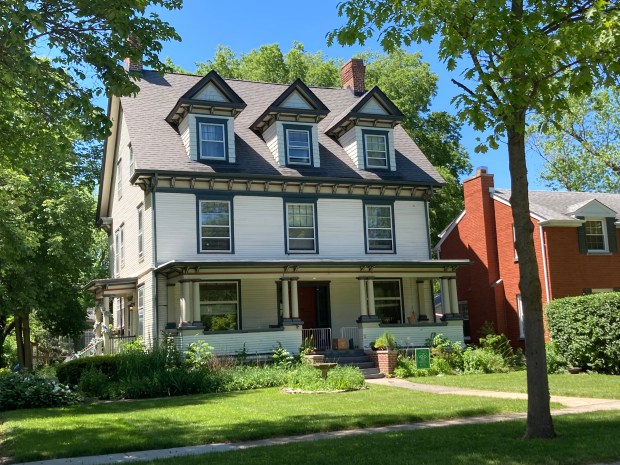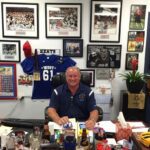It’s a good time for anniversaries.
Aside from personal milestones, area businesses, libraries and other institutions throughout the area are celebrating longevity.
And south suburban municipalities, in particular, are aging with grace. A year after Lemont, the old dean of south suburbs, marked 150 years since its incorporation. Park Forest, a modern suburb established at midcentury, is logging its 75th year.
And next month, the village of Flossmoor will celebrate its centennial from 4:30 to 9 p.m. June 20 at Flossmoor Park, Brassie Avenue and Flossmoor Road, with baseball as its centerpiece. The park is the longtime home to the village’s youth baseball and softball operations dating back to the 1960s.
The 100th anniversary event also will include a vintage baseball game between the Flossmoor Whistlestoppers and the visiting Deep River Grinders from Hobart, Indiana. There also will be a car exhibition showcasing vehicles from each decade of Flossmoor’s official existence, and a drone light show at the end of the evening.

In a news release touting the event, Flossmoor’s official birthday is dated to a June 1924 meeting in the “garage of a large home on Sterling Avenue,” where the village’s boundaries were determined and a vote on incorporation was taken.
“Ten days later, Cook County duly authenticated the matter of incorporation, and the Village of Flossmoor was founded on June 20, 1924,” the release states.
While the village likely has incorporation documents to back up its birth date claim, 10 days seems an overly efficient navigation of Cook County bureaucracy.
The seminal Homewood/Flossmoor history booklet “Indian Trails to Tollways” published in 1968 by Anna B. Adair and Adele Sandberg, as Homewood was marking its “Diamond Jubilee,” or 75th anniversary in modern parlay, offers more insight into the origin of the plan.
The authors said the idea to turn a Scottish-themed neighborhood created years earlier on land owned by the Illinois Central Railroad into a village was floated at a Community Leap Year Dinner given by the PTA in the basement of Leavitt Avenue School.
“While the men were gathered in the furnace room for a smoke, the subject of incorporation was casually brought up,” the book reported. The authors had compiled their information at a time when some of the younger men at the meeting may still have been alive, furnace room smoking habits notwithstanding.

Flossmoor’s deeper origins stretch back to a gamble on the area’s soil quality that didn’t pay off. The Illinois Central Railroad purchased land adjacent to its tracks in 1891 in Chicago’s rural hinterland with plans to “strip the land of its black dirt and have it hauled to Chicago for use on the fair grounds for the (Columbian) Exposition of 1893,” which was adjacent to its tracks in Hyde Park.
But the dirt contained too much clay. Instead, the railroad company got into the residential real estate business, subdividing the land and giving free lunches to anyone they could lure onto sales-pitch excursion trains.
Of those who bought in and stuck around, along with neighbors who joined them over the following 30 or so years, 78 people voted to incorporate Flossmoor as a village, and 60 people thought it was a bad idea. A few years later, they got to work on establishing the village’s first park, at Flossmoor Road just east of the tracks. In the 1940s, a small field house was constructed and surrounded by baseball fields, tennis courts and an ice rink in winter. All still remain at the site and will host the village’s centennial event in June.
A small parcel of land between the park and the railroad tracks appeared to be part of the park, but it was never officially transferred from The Illinois Central to the village or park district. Instead it remained in limbo for well over a century, said Kristine Condon, who has published a new collection of essays on Flossmoor’s history in time for the village’s centennial.
“Fragments of Flossmoor: A Series of Essays on the Interesting, Curious, and Unique in Our Village,” a 128-page book is the second area history book by Condon, following up on her public art deep dive in “Richard Haas Murals in Homewood, Illinois,” published in 2020. The new book is only available on the Flossmoor Veterans Memorial site at flossmoorvets.square.site/, though she will be selling copies at a June 29 presentation at The Rock Shop in Homewood.
“I didn’t want to restate well known history, like ‘Trails to Tollways’ or the ‘Images of America’ book that was done for Flossmoor’s 75th,” Condon said. “I wanted to make sure these were little known pieces of Flossmoor history, that I felt were important to be preserved.”

The story of that triangle of land is one of her favorite vignettes in the book, because it ties in directly to its purpose as a fundraising item for the new Flossmoor Veterans Memorial planned at the site.
“That triangle is such a well-kept secret,” she said. “Part of the challenge we had with this site was that it was an ideal location, but we didn’t know who owned it. The H-F Park District said we mow it, the village of Flossmoor said we maintain it and my dad said he remembered climbing that sycamore tree as a kid and thought the railroad owned it. The railroad didn’t know who owned it — they had no record of it.”
The volunteers behind the Veterans Memorial project spent a day at the county recorder of deeds office and finally confirmed it was owned by the Illinois Central Railroad and its successors since 1910, Condon said.
“There’d been no transactional activity on that parcel for 115 years, and that’s why nobody knew who owned it,” she said.
One reason Condon is so passionate about the project is her grandfather helped establish the village’s original Roll of Honor during World War II when he was commander of the now defunct Flossmoor American Legion Post 625.
“My dad recalled the evenings my grandparents spent in the dining room gluing alphabet soup noodles onto wooden placards to provide 155 names of recognition on that honor roll,” she said.
Wartime scarcity of materials required creative reuse of everyday materials. When he was done, the Honor Roll was placed prominently downtown, where the village’s library now is.
“Grandpa’s intent was that it be a temporary marker until the American Legion could raise the funds for the remainder of it,” Condon said. Years went by and priorities in the village changed, and a permanent veterans memorial never materialized.
“I knew how important it was to him, and I know how important it is to my dad to see this work finished when my grandfather didn’t live long enough to see a permanent wall of honor in place,” she said.

So in 2021, she teamed up with former Flossmoor Mayor Paul Braun and others to begin fundraising to make her grandfather’s wish a reality. Last January, the Flossmoor Veterans Memorial group received preliminary site plan approval and a special use permit for the memorial from the Village Board. They’ve also raised over $110,000 to fund the project, though they’re still seeking more support.
Condon said all proceeds from the sales of her Flossmoor book are going toward the project, but that’s not the only reason she dove into the project. It will also be a resource, she said, for junior high students participating in a unit on village history being planned by the veterans memorial group with Flossmoor Elementary District 161.
To that end, she’s included stories about famous Flossmoor residents, such as presidential historian Michael Beschloss, who grew up in a house on McDonald Lane.
“As a young boy after Kennedy was assassinated he wrote a letter to President Johnson and asked Johnson to hire, as he put it, a large carving firm to put JFK’s bust on Mount Rushmore,” Condon said. “Johnson’s secretary Juanita Roberts wrote Michael back and acknowledged the receipt of his letter. That material is in the national archives, and that address is on file in the National Archives.”
Another essay relates to Winnifred Mason Huck, the first female representative from Illinois to serve in Congress. Only the third woman in the House from anywhere in the country, she advocated for child labor laws and bonuses for World War I veterans, among other causes, during her one term in office. She was present at the dedication of the Flossmoor Civic Center building, the main element of the village’s downtown area, in 1929.
Beyond its educational aspects, Condon hopes her book, and the larger Flossmoor Veterans Memorial project, can help “cultivate the power of community” in the village.
“Everyone in the Flossmoor community has something or story they can contribute to this project, as well try to make meaning of the contributions of the people who came before us,” she said.
Landmarks is a weekly column by Paul Eisenberg exploring the people, places and things that have left an indelible mark on the Southland. He can be reached at [email protected].
Paul Eisenberg , 2024-05-26 13:09:26
Source link


